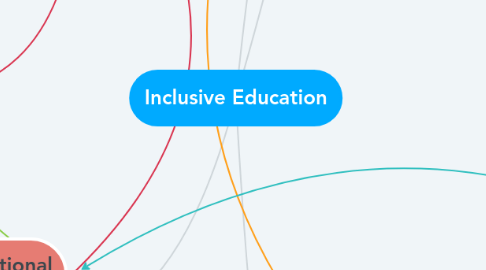
1. Social and Emotional Learning
1.1. Respecting Diversity Program
1.1.1. Start with this at the beginning of the school year to build the class community
1.2. Support Self-Worth
1.2.1. It's very important for students to feel a sense of belonging in their class
1.3. Class meetings
1.3.1. Provide students with the opportunity to communicate and problem solve
1.4. Spirit Buddy Program
1.4.1. Have students connect each day or a few times a week to "check in" with each other and see how they each are doing
1.5. Problem solving strategies
1.5.1. ACCEPTS
1.6. Support Social Learning
1.6.1. Centres allow for working in large or small groups
1.6.1.1. Crucial to establish expectations before centres time, show respect for self and others
1.7. Integration: all students learning together
2. Build a Community
2.1. Gifted Students
2.1.1. Important for gifted students to find peers their own age
2.1.2. Students need to see that they're not the only one who thinks like them, but also learn how to work with others
2.1.2.1. Teach with a balance of the two of these setups
2.2. Physical Classroom Setup
2.2.1. Should invite and support students
2.2.2. Should facilitate easy transitions
2.3. Help each student feel that they belong
2.3.1. How can student contribute to these inclusive environments?
2.4. Classroom Ecology
2.4.1. The environment of the classroom and the students and teachers are always interacting
2.4.2. Each aspect of a system affects all others
3. Self Regulated Learning
3.1. Multiple Intelligences: How can students help themselves and each other with their strengths?
3.1.1. Each student can feel smart in their own way
3.2. Assessment
3.2.1. Self Assessment: Students identify their strengths and challenges from the MI list in the RD program, and take initiative to get help from students strong in that area
3.3. Use of medicine wheel to incorporate Indigenous knowledge, and teach emotional intelligence
3.3.1. Spiritual
3.3.2. Mental/Intellectual
3.3.3. Physical
3.3.4. Emotional
3.4. Teach students coping strategies for themselves, and strategies to help others
3.4.1. Teach the whole class coping and helping strategies so the class can work together to support each other inside and outside of school hours
4. Providing Support
4.1. Universal Design for Learning
4.1.1. Engagement
4.1.2. Action and Expression
4.1.3. Representation
4.1.4. Designed to help one student, but benefits all
4.1.4.1. Teach conceptual representation
4.1.4.1.1. Writing is not the only medium for students to communicate their understanding!
4.1.5. Students should be able to have independence
4.1.6. Technology as a tool for accessibility and integration
4.1.7. Unit Planning: Pick a subject area, Pick a topic, determine the curricular goals for ALL students, then for MOST students
4.1.8. 3 block model of UDL
4.1.8.1. Systems and Structures
4.1.8.2. SEL
4.1.8.3. Instructional Practice
4.2. Support cognitive challenge
4.2.1. Bowling Metaphor: Shelley Moore "Aim for the Outside Pins to hit them all"
4.3. School Act
4.3.1. Teachers/Educators are required by law to be inclusive of all students
4.4. Every student has their own challenges - How do we support them to reach their goals?
4.4.1. Work collaboratively
4.4.2. Be thorough of assessment of student strengths and challenges in each "intelligence" to gain understanding of how best to support that student
4.5. Literacy teaching and learning
4.5.1. Integrate literacy learning so all students read, write, speak, and communicate at a level that is accessible and challenges are attainable
4.6. Providing safe classrooms for LGBTQ2S+ Students
4.6.1. SOGI 123 Resources
4.6.2. Create an inclusive and accepting environment regardless of if it has already "come up" in your class
4.7. The levels of a students' achievement aren't helpful, it's the cause that matters!
4.7.1. Why might a student be finding a learning process challenging? You need to know the "Why" in order to decide the best way to teach that child.
4.7.1.1. Wait time is one of the best gifts you can give to a class, so everyone can contribute and have appropriate think time
4.8. Levels of Assessment
4.8.1. Three levels of assessment, titled A, B and C
4.8.1.1. Level A is curriculum and performance based assessments..typical assessments teachers would do
4.8.1.2. B are standardized or norm tests
4.8.1.3. C is mostly done by educational psychologists
4.9. IEP
4.9.1. Potential framework IEP - Medicine Wheel which is a more holistic approach
4.9.2. Really important documents that can and should be used to set students up for success
4.10. Numeracy requires relevance
4.10.1. Teach what is this, where would we use it, then teach the how
4.10.2. Have students work collaboratively for success
